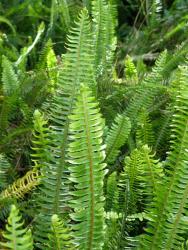Terrestrial, rupestral or epiphytic ferns. Rhizomes erect or short-creeping, scaly, often producing long-creeping runners that form adventitious buds and sometimes bear tubers. Rhizome scales ovate or narrowly ovate, basifixed or peltate, concolorous or with pale margins and dark centres, bearing marginal hairs or teeth. Fronds monomorphic, not articulated to the rhizome. Laminae 1-pinnate, herbaceous, scaly and sometimes hairy. Pinnae articulated to rachis, entire or lobed, sometimes auricled on acroscopic side. Veins free, ending in hydathodes near the lamina margin. Sori round (NZ) to elongate (not NZ), borne on abaxial surface, submarginal to medial (NZ) or rarely marginal (not NZ); paraphyses absent; indusia attached on one side, reniform to lunulate (NZ) or rarely linear (not NZ). Spores monolete, lacking chlorophyll; perispores tuberculate, verrucate or rugose.
A genus of c. 19 species (Hovenkamp & Miyamoto 2005).
Nephrolepis has been reviewed in its entirety by Hovenkamp & Miyamoto (2005). The Malesian taxa have been revised by Hovenkamp & Miyamoto (2012) and the Neotropical species treated by Mickel & Smith (2004). Analysis of plastid DNA data from three regions by Hennequin et al. (2010) identified three main clades in the genus, with two lineages diverging early and becoming isolated in the Neotropics and in Asia–Australia. More recently there has been expansion into Africa from the Asia–Australia region.
Within New Zealand, Allan (1961) recognised two indigenous taxa, which he referred to N. cordifolia and N. exaltata (now N. brownii). Within the N. cordifolia complex, Brownsey (in Webb et al. 1988) documented both a native and a naturalised species, based on observations made in several earlier publications (see Notes under N. flexuosa for a full discussion). Although Hovenkamp & Miyamoto (2005) did not recognise this distinction, referring both taxa to N. cordifolia var. cordifolia, de Lange et al. (2005) reinstated the name N. flexuosa for the native species that, in New Zealand, is confined to thermal regions of the North Island and Raoul Island (Kermadec Islands group), and cytologically distinct from N. cordifolia (de Lange et al. 2004). Large (2016) and Large & Farrington (2016) have since shown that N. exaltata is also naturalised in parts of northern New Zealand.
Some species of Nephrolepis, notably N. exaltata and N. cordifolia, are widely cultivated around the world and are now naturalised in New Zealand and many other places. Their ability to grow vegetatively by means of runners and tubers ensures that they can establish easily from garden escapes and spread aggressively in warmer regions. Morton (1958) catalogued the species and forms of Nephrolepis then known to be in cultivation, including 14 cultivars and varieties of N. exaltata, and more recent information has been provided by Hoshizaki & Moran (2001).
| 1 | Some primary pinnae pinnatisect in distal half | cordifolia ‘Plumosa’ |
| Primary pinnae undivided | 2 | |
| 2 | Indusia lunulate, usually lacking a distinct sinus | 3 |
| Indusia reniform, with a distinct sinus | 4 | |
| 3 | Tubers absent; longest pinnae 9–25 mm long; mean spore size 36–39 μm long, 23–25 μm wide | flexuosa |
| Tubers present; longest pinnae 15–53 mm long; mean spore size 28–33 μm long, 18–22 μm wide | cordifolia | |
| 4 | Scales on rhizome and stipe base spreading, dull; sterile pinnae not strongly auricled acroscopically; pinna margins minutely serrate | exaltata |
| Scales on rhizome and stipe base appressed, shining; sterile pinnae strongly auricled acroscopically; pinna margins irregularly serrate or lobed | brownii |
In New Zealand, species of Nephrolepis can be recognised by their erect rhizomes that often produce runners bearing adventitious buds and sometimes tubers, 1-pinnate laminae that are scaly and sometimes hairy, submarginal or medial sori protected by reniform or lunulate indusia, and tuberculate, verrucate or rugose spores (Large & Braggins 1991).
Nephrolepis is pantropical in distribution, but most species are confined either to the Neotropics or to the Paleotropics, with a few extending into the southern temperate zone. The greatest diversity is in the Malesian region, where 15 species are recognised (Hovenkamp & Miyamoto 2012): seven indigenous and one naturalised species in the Neotropics (Mickel & Smith 2004), six indigenous and one naturalised in Africa (Roux 2009), six in Australia (Bell 1998), five or six in the south-west Pacific (Nakamura 2008), and two indigenous and three naturalised in Hawai‘i (Palmer 2003). Four species in New Zealand: two indigenous and two naturalised.
| Category | Number |
|---|---|
| Indigenous (Non-endemic) | 2 |
| Exotic: Fully Naturalised | 1 |
| Exotic: Casual | 1 |
| Total | 4 |
The base chromosome number in Nephrolepis is x = 41 (Kramer 1990).




